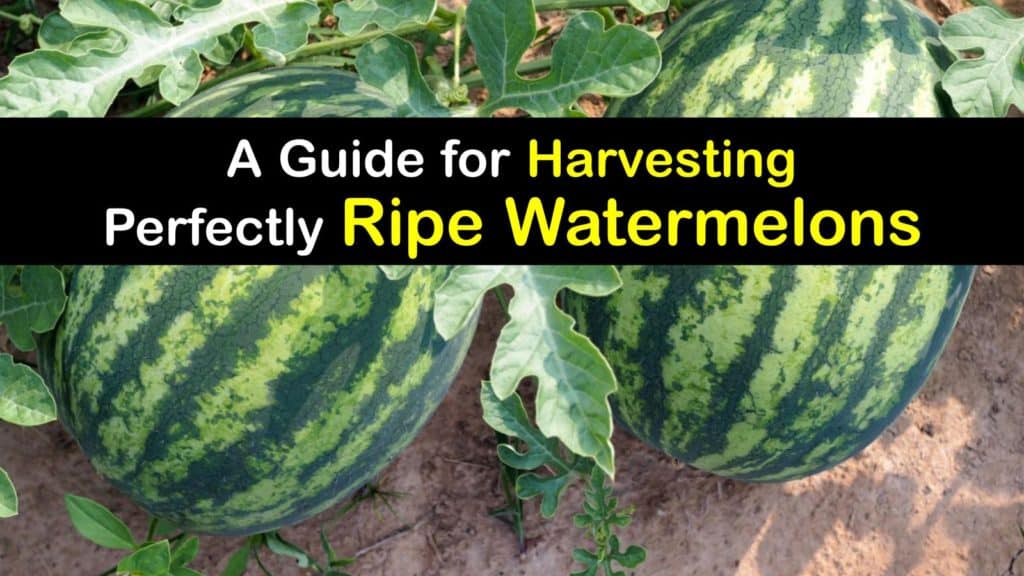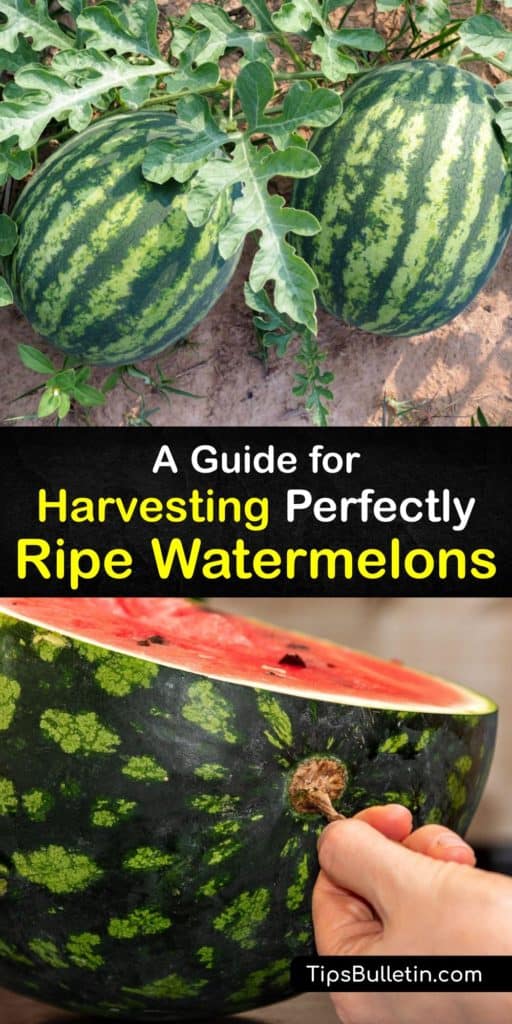When Do You Know It's Time To Pick The Cantaloupe Out Of Your Garden
Watermelon fruits are big, green, and absolutely delicious. Even though we don't always have the best luck at finding the sweetest melons at the store, there are ways to pick them from your garden at the perfect time. Knowing when to harvest watermelon makes a significant difference in the flavor of your crops.
Harvesting watermelons doesn't seem like it's that important. After all, you should be okay with harvesting it when it reaches a specific size, right? Unfortunately, that isn't entirely correct.
Although size is a fair indication of readiness, there are a few more things that you might want to consider. Knowing how to harvest watermelon is something that anybody can learn.
The more your work with different watermelon varieties, the easier it becomes to know when they are ready to cut from the vine and eat.
Nobody wants to eat unripe watermelon, cantaloupe, muskmelons, or any other plants from the melon family. With this guide, you'll know when to pick watermelon when they are large, juicy, and oh so sweet.

- About Harvesting Watermelons
- How to Grow Watermelons
- Propagating Watermelon
- Growing Watermelons
- When to Harvest Watermelon
- How to Harvest Watermelon
- Storing and Eating Watermelon
About Harvesting Watermelons
Gardeners who have never grown watermelon plants before assume that these crops are an enormous undertaking, yet they haven't put in the effort to find out if that's true or not.
Growing watermelons is a lot simpler than you may think. Despite their large size, these plants aren't too picky about how they're cared for.
Watermelon plants are known for being sweet, juicy, and refreshing on a hot summer day. They are made of over 92 percent water and keep many people hydrated when they can't stand to be outside during the hottest summertime days.
It's surprising to learn that their ability to hydrate us so quickly comes from their history when humans first cultivated them.
Watermelons are native to Africa in places where both food and water are scarce. The thick rind of the plant allowed us to store the melons for long periods and transport them without doing a lot of damage.
Although there are still many wild watermelon plants that grow in Africa, they have been cultivated often enough that they now grow well in places worldwide.
In the United States, watermelons are consumed for the pink inner flesh, yet other cultures cherish the watermelon seeds. Even the rind is edible and can be turned into tasty snacks.
Watermelons grow on long vines similar to their close relatives, such as honeydew, squash, gourds, and cucumbers. While most of these fruits have long bodies, watermelons are oblong with many different skin patterns.
If you're interested in when to harvest watermelon, you have to start learning how to grow them. Once you know how to care for them, it won't be much longer before it's watermelon harvest time.
How to Grow Watermelons
You can't know how to harvest watermelon if you don't first learn how to grow them. Don't be intimidated by this task. Even though they're big, watermelons are one of the easiest fruits to start growing.
Propagating Watermelon
We wish it were as simple as running outside with a packet full of watermelon seeds and spreading them around the yard.
However, even though you're on the right track, be sure to check the package for the listed number of days that it takes for your chosen cultivar to reach maturity. This number of days gives you an idea about if you'll need to start your plants indoors or not.
Melons are often most successful when the seeds are sown directly into your garden beds, as with cantaloupe vs melon. They have sensitive roots and don't do well after being transplanted. However, sowing seeds directly into the ground does not work well for all cultivars and all climates.
How long does it take for watermelon to grow? Some watermelon varieties take over 100 days to mature, and it's often necessary to begin an early growing season indoors.
When propagating seeds, choose types that can grow during your USDA hardiness zone's entire growing season.
Direct sowing is one method for planting watermelons. Watermelons enjoy hot weather and don't tolerate cold temperatures or frosts. Ensure you use some patience and wait at least two weeks after your last frost date in the spring.
Germinate watermelon seeds when the soil temperature is a minimum of 60°F, yet the ideal temperature is 95°F.
If you have prepared your melon patch and the soil is warm, sow the seeds into moist soil about one inch deep. Smooth the surface over with some extra dirt and then water them to make everything moist.
Transplanting watermelons is a bit different. Wait until daytime temperatures remain above 70°F before transplanting them outdoors. Disturb the roots as little as possible.
Growing Watermelons
Site selection is crucial to have a mature and ripe watermelon. These plants enjoy spreading out, and they take up a lot of space. Ensure you choose an area with lots of room for growth where they won't disturb their nearby neighbors.
If the space is limited, train the vines up a trellis to move them out of the way. Do not plant watermelons where other cucurbit plants grew over the past three years to reduce their risk of disease.
Once you pick your site, check to ensure it has full sun with at least eight to ten hours of direct sunshine every day. The more sun there is, the better off your watermelons are. Because they enjoy the heat, consider using a cold frame or greenhouse to make them even happier.
Watermelons do best in loose and well-draining soil. Keep the pH range between 6.0 and 7.5. Amend poor dirt with organic matter and compost for extra nutrition.
Mound dirt hills around the base of your plants to help protect the roots and keep excess water away from them. You may control soil temperatures by adding mulch to the ground as well.
Once you prepare the beds, add fertilizer to amend any nutrient deficiencies. Rotted manure is the best fertilizer for melons, though any all-purpose fertilizer is fine.
Water your melons whenever the top inch of soil is dry. They thrive on one to two inches of water per week. As the fruits ripen, consistent watering is essential to prevent cracking.
If you aren't reliable with your schedule, this could damage all of your cultivars that are resistant to cracking, like the Sugar Baby and Mini Love melons.
One of the most critical aspects of growing watermelon plants is making sure that there are both male flowers and female flowers.
Without both, pollination isn't possible, and you'll have an awfully short growing season with no reward at the end. If essential pollinators and other critters aren't pollinating your crops, you'll have to use a cotton swab to do it by hand.
Try to use floating row covers to keep pests away from your crops. One of the most common is cucumber beetles, but these are easy to remove by hand. Your biggest concern should be fungal diseases. You'll likely have to spray your crops to protect them.
When to Harvest Watermelon
When are watermelon ready to harvest, and how do you determine ripeness? Anyone can learn how to harvest watermelon. Pay attention to this next section full of tips on picking watermelon at the perfect time.
How to Harvest Watermelon
Watermelons do not continue to ripen once you pick them from the vine, so wait until fully ripe to remove them from the vine. Keep in mind that they go from unripe to spoiled in a matter of days. Be vigilant about checking on them once they reach maturity.
Count the number of days to maturity after you plant them to know when they are getting close to being ready.
They are ripe when the fruit has separated from the vine, and the vine itself has started to die. If still attached and the vine remains alive, there are a few ways to tell if you are ready to remove them.
Look for a curly tendril closest to the stem that attaches to the melon. The leaf closest to that tendril will turn brown or yellow when it is ready.
Next, check the underside of the melon. If there is a light green or creamy white spot, it is ripe. Wait for the rind to turn from shiny to dull before picking.
The blossom end of the melon softens when ripe. When all else fails, try the thump test. This test isn't the most reliable way to determine ripeness, but it works when you're in a pinch at the grocery store. If there is a hollow sound after you knock, the fruit is likely overripe.
Storing and Eating Watermelon
After you harvest your melons, use them right away. Intact fruits last for seven days at room temperature. To lengthen watermelon shelf life, store watermelons in a cool basement or root cellar.
Do not store watermelon in the fridge if possible unless it is cut. If cut, store and preserve watermelon in the fridge in an airtight container.
Can watermelon go bad quickly? Cut watermelon lasts several days in the fridge before it gets mushy. You can also turn it into a tasty dessert rich in potassium that lasts for months in the freezer.
tb1234
Watermelon Sorbet
- 1 cup sugar
- ½ cup water
- ¼ cup lemon juice
- 3 cups watermelon
tb1234
Cook the water, white sugar, and lemon juice over medium heat until the sugar dissolves. Remove the syrup mixture from the heat and allow it to cool in the fridge.
Cut your watermelon and remove the seeds. Puree the melon in a blender and stir it into the chilled syrup. Freeze the contents in an ice cream maker. Pack it into an airtight container and store the sorbet in the freezer.
Summer wouldn't be the same without perfectly ripe watermelon. Knowing how to harvest watermelon is a bit tricky. Thankfully, there are many simple ways to determine when to start harvesting watermelons from your garden beds.

If learning when to harvest watermelon has given you plenty of sweet summer treats, share this guide for harvesting watermelon on Facebook and Pinterest.
When Do You Know It's Time To Pick The Cantaloupe Out Of Your Garden
Source: https://www.tipsbulletin.com/when-to-harvest-watermelon/
Posted by: smithloond1969.blogspot.com

0 Response to "When Do You Know It's Time To Pick The Cantaloupe Out Of Your Garden"
Post a Comment